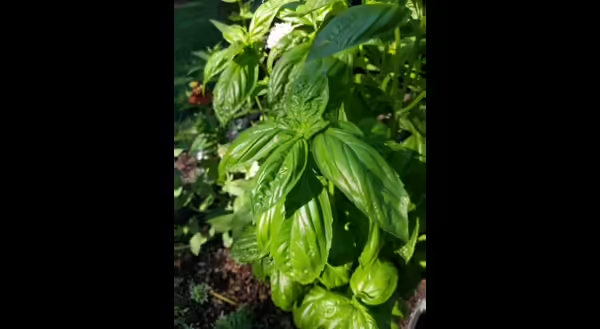
Every gardener has several of those go-to plants, the ones that seem to always grow nicely in their particular gardening system, making them a repeated addition over the years. I just love it when one of these go-to specimens can not only provide ornamental beauty, but an edible harvest as well.
For my family, basil (Ocimum basilicum) has filled this niche over the years. We have planted it in traditional vegetable gardens and ornamental landscape beds alike. It has a wonderfully textured foliage adding smooth and shiny, bright green leaves to the empty foreground of a flowerbed or to fill in the occasional empty space in our herb garden. Each year, we add a number of these annuals to both the garden and the landscape with the promise of multiple harvests of aromatic, spicy leaves for many of our favorite dishes.
The basil plant originated in Asia and Africa where it grows as a perennial herb in more tropical climates. In temperate regions around the globe, like ours, it is not winter hardy and must be planted annually.
Due to its tropical origins, warm weather is the key to growing productive basil plants. Many gardeners start basil from seed, either indoors about 3-4 weeks before the risk of frost has past or directly seeded outside once the spring weather is frost free. Seedlings tend to grow slowly while spring weather is cool, putting on significant growth once the heat of summer arrives.
A typical basil plant can grow up to about two feet tall in full sun and free of competition from other plants. The attractive, bright green foliage adds a wonderful layer of smooth and shiny leaves to landscape beds or contrasts nicely with the more fine textured foliage of other herbs such as rosemary or thyme. A number of basil varieties have beautiful dark purple foliage that really adds addition color and texture to many plantings.
Basil flowers are quite showy as well, being a favorite among pollinating insects. However, since basil is typically harvested for it foliage, many gardeners choose to remove flower buds as they start to form. By pinching off the buds, the plant’s growth is redirect toward foliage, as opposed to flower and seed production. It results in a bushier plant with higher quality leaves for harvest. If allowed to flower, basil's leaves tend have less flavor and aroma, although still harvestable.
The practice of pinching back flower buds may be one main reason why basil is a reoccurring annual each year in my gardens. I absolutely love the therapeutic nature of spending few minutes pinching off the highly aromatic buds. They are easily remove with a light pinch, releasing a burst of sweet and spicy smell. The fragrant oils from basil tend to accumulate on your fingers as you work through the plant, sending you off with the wonderful aroma.
Harvesting basil can be done intermittently, as needed for cooking, or entire plants can be harvested at once for larger recipes. My family really enjoys basil as a pesto-style sauce, so we tend to make a few larger harvests, while saving a few individual plants for continual harvest throughout the growing season. During the hot part of summer, basil plants are incredibly productive, which allows for multiple harvests.
Basil also works well as a dried herb, but must be harvested well before any risk of frost. Plants that have been allowed to flower and produce seed, make a wonderful long-lasting dried arrangement when hung and dried as whole plants. So, even if the bud pinching gets away from you the plant still has uses and will attract the pollinators during its flower display.
Basil is such a commonly available and popular herb that plants are easily sourced from local garden centers, or I have even seen basil plants in the produce section at grocery stores nearly year round. Although I typically start plants from seed, it never hurts to pick up a few seedlings since I can almost always find a space to squeeze them in a garden bed or an empty container for fill. With its easy harvest and management, along with aromatic ornamental beauty, basil is an annual more gardeners should consider including in both culinary and ornamental garden spaces.